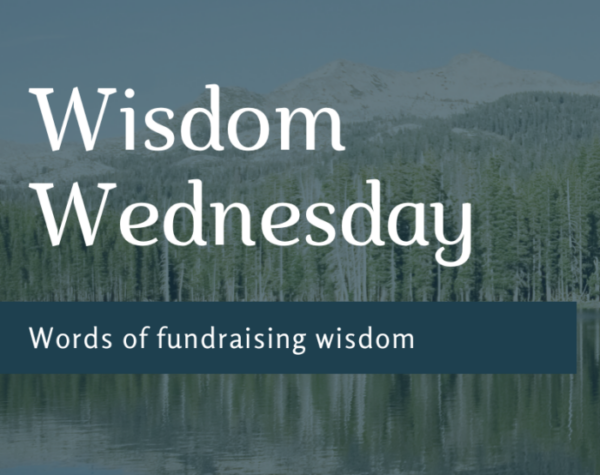5 Things to Keep in Mind about Planned Giving During a Capital Campaign
 You’re ramping up for a Capital Campaign and want to avoid donor fatigue, so you decide to hold off on talking about making a planned gift. This way, you can keep donors laser focused on the needs of the organization.
You’re ramping up for a Capital Campaign and want to avoid donor fatigue, so you decide to hold off on talking about making a planned gift. This way, you can keep donors laser focused on the needs of the organization.
Before you land on this decision, consider the alternative: introduce planned gifts as an option for philanthropy and to help meet your organization’s long-term goals. This takes a shift in perspective, moving from a silo view of giving toward more of a holistic view. That really means thinking of “giving” and “philanthropy” from the perspective of a donor.
It also takes a shift in perspective in what you believe about the intent of your donor. Imagine how it would change the conversation if you could shift your belief from, “I need to ask this donor to donate to meet our campaign goals,” to “This donor loves our mission, and it would make him/her feel good to invest in something they love.”
When you allow a planned gift intention to “count” toward your capital campaign goals, you help your donors realize assets other than cash can impact the organization. Not only that, studies show donors who make a planned gift increase their annual donations and major gifts–which benefits the organization (even if it doesn’t go toward the immediate needs of the capital campaign).
You continue your annual appeal during a capital campaign, so keep your planned giving efforts on track, too.
5 things to keep in mind about planned giving during a capital campaign:
Planned gifts are the MAJOR gift of the rank-and-file donor
Capital campaigns provide moderate-but-loyal donors the opportunity to get involved. Conversations intended to focus on an ask for the capital campaign can help identify warm, and potentially very viable prospects for planned gifts. There should be little fear that planned gifts identified during a capital campaign will cannibalize the capital campaign’s goals.
Planned giving happens on the donor’s time-frame, not the organization’s
The organization’s big focus is the capital campaign, but that doesn’t mean that’s the focus of the donor. Don’t lose sight that planned giving happens all the time, even during major campaigns. The two may coincide unintentionally—and that can work to your benefit.
Consistency and frequency is the key to success for any planned giving marketing campaign
It’s crucial for your potential donors to see your planned giving message during life’s big moments. But you don’t know when those moment will happen, so going silent is a bad choice–especially if it’s for months or even years while you market a capital campaign. Imagine how much opportunity you could miss. If you stop then restart your planned giving conversations, you slow the momentum and efficacy of the ask. A consistent and frequent planned giving marketing strategy is always the best practice.
In addition to losing momentum, a lack of planned giving marketing could imply that the program is not important to the organization.
Capital Campaigns mean increased marketing budgets
Capital campaigns give you a great opportunity to tag along on bigger marketing initiatives, with little to no additional cost!
Work with your development colleagues to ensure there is a planned giving message included in all capital campaign marketing, including emails, pledge forms, on the webpage, in print materials, etc. While planned gifts don’t technically count towards the campaign’s bottom line goal, fostering participation from a segment of your donor file encourages those who want to make a planned gift come forward. They can feel part of the campaign to “give big” in a way they can, even if the dollars are deferred.
When you include planned giving marketing during your capital campaign, it encourages philanthropy.
This is ultimately the goal of all fundraising marketing. By continuing to inspire donors with planned gifts, despite additional fundraising campaigns, you are able to:
- Drive awareness of your planned giving program
- Build your planned giving pipeline
- Show the value of planned giving to the bottom line
It’s a win-win-win!
If you need help integrating planned giving marketing with your capital campaign, give us a call at 484-680-7600.

70 ½ vs. 73?
70 ½ vs. 73? We’ve been hearing some confusion from a lot of clients around the age split of 70 ½ vs. 73 for gifting from an IRA. Which is the correct age? What are the rules around each age? When it comes to marketing this great gifting strategy, the problem is both...

Wisdom Wednesday – Are you 85?
Are you 85? I didn't think so ...We've talked about the mindset of our most senior donors in the past. And we'll most likely talk about it forever. Why? None of us know what it's like to be 85 - unless we're 85.We've all been 16 before. Most of us have even recovered...

Generational Marketing – Traditionalists
Generational Marketing - TraditionalistsTraditionalists include those aged 77+ and will be a key group when it comes to your planned giving outreach.Learning how to communicate with this portion of the population is important for your success. Discovering the nuances...
Tech Tuesday – IRS Discount Rate
IRS Discount Rate With the signing of the Consolidated Appropriations Act of 2023 and the provision referred to as Secure 2.0, there is newfound interest around Charitable Gift Annuities* (CGAs). Because of this we’re all becoming reacquainted with the IRS...
